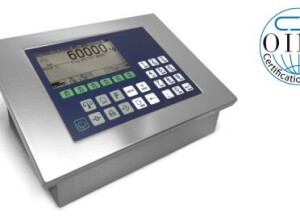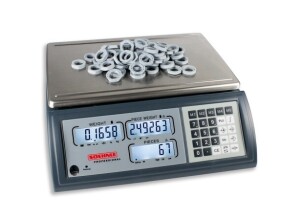Weighing Glossary: 100+ Terms Explained
This comprehensive glossary covers terms, concepts, and technologies used in weighing, from basic kitchen scales to industrial systems, AI, IoT, and legal metrology. It includes equipment, components, software, and measurement principles.
A
Accuracy
The degree to which a measured value conforms to the true value.
AI (Artificial Intelligence)
Use of algorithms and machine learning to improve weighing accuracy, predictive maintenance, sorting, and data analysis. See also: Artificial Intelligence in Weighing Systems.
Analytical Balance
High-precision laboratory scale used to measure very small masses, typically milligrams or micrograms. See also: Laboratory & Educational Balances.
Auto-Tare
Function in electronic scales that automatically subtracts the weight of a container.
B
Balance
Device used to determine mass by comparing an unknown mass with a known standard.
Beam Scale
Mechanical balance with a horizontal beam and sliding weights for measurement.
Body Composition
Measurement of fat, muscle, and water content in the human body, often provided by smart scales.
Brake Load Cell
Load cell used in systems measuring braking forces or dynamic vehicle weights.
C
Calibration
The process of adjusting a scale to match known standard weights. See also: Calibration & Traceability.
Checkweigher
Scale used in production lines to verify that product weights are within specified limits.
Container Tare
The weight of a container subtracted from gross weight to calculate net weight.
Connectivity
Ability of a weighing system to communicate with software, PLCs, cloud platforms, or other devices via Ethernet, Wi-Fi, or serial interfaces.
D
Digital Scale
Scale providing weight readings on a digital display.
Display Panel
The part of a scale showing weight or measurement results, can be LED, LCD, or touchscreen.
Draft Weight
Weight measurement of a product before packaging or processing.
Dynamic Weighing
Measuring weight of an object or vehicle while in motion, such as with WIM systems.
E
Electronic Scale
Scale using electrical components and load cells to measure weight.
Excess Weight
Amount of weight over a specified limit, often used in transport and trade compliance.
Ethernet Interface
Communication port for connecting a weighing system to a network or software system.
F
Force
Interaction that changes the motion of an object; weight is a force due to gravity acting on mass.
Floor Scale
Heavy-duty scale designed for large, heavy items; commonly used in warehouses and logistics. See also: Platform & Floor Scales.
Firmware
Software embedded in weighing terminals or indicators that controls functions and processing.
G
Gross Weight
Total weight of an item including packaging or container.
Guardrail
Safety structure around large scales or truck weighbridges to prevent vehicle misalignment or accidents.
H
High-Speed WIM
Weigh-In-Motion system for measuring vehicles at highway speeds. See also: Weigh-In-Motion Systems.
Human Scale
Scales designed to weigh people, e.g., bathroom, medical, or fitness scales.
Hopper Scale
Scale used to weigh bulk material stored in a hopper, commonly in industrial and agricultural settings.
I
Indicator / Weighing Indicator
Device that receives signals from load cells or sensors and displays the weight, often with additional functions like printing or communication.
IoT (Internet of Things)
Integration of scales and sensors with cloud platforms for real-time monitoring and automation. See also: Weighing Software & IoT Integration.
Integration
Connecting weighing systems with ERP, MES, or automation systems.
J
Junction Box
Device connecting multiple load cells in a scale system and transmitting the combined signal to the indicator.
Jib Crane Scale
Suspended scale used with cranes to weigh lifted loads safely.
K
Kilogram (kg)
SI unit of mass, standard for weighing instruments worldwide.
Kitchen Scale
Compact scale for weighing food and ingredients. See also: Kitchen Scales Guide.
L
Legal-for-Trade
Certification indicating a scale is approved for commercial transactions. See also: Weighing Standards & Legal Metrology.
Load Cell
Electronic sensor converting weight into electrical signals for measurement.
Linearization
Process that adjusts the scale's output to match weight accurately over the full range.
M
Mass
Quantity of matter in an object, measured in kilograms or grams.
Microbalance
Highly sensitive balance measuring micrograms. See also: Laboratory & Educational Balances.
Medical Scale
Scale designed for healthcare, patient monitoring, and clinical applications. See also: Medical & Healthcare Scales.
Motion Sensor
Device detecting movement of an object on a scale or WIM system to trigger measurement.
N
Net Weight
Weight of an item excluding packaging or container.
Nominal Load
Maximum rated weight a load cell or scale can measure accurately.
O
OIML
International Organization of Legal Metrology, providing recommendations for weighing instruments. See also: Weighing Standards & Legal Metrology.
Overload Protection
Feature in scales to prevent damage when weight exceeds the rated capacity.
P
Platform Scale
Scale with a flat platform for weighing large or heavy items. See also: Platform & Floor Scales.
Printer
Accessory to print weight tickets, labels, or reports directly from the weighing system.
Precision
Degree to which repeated measurements under unchanged conditions produce the same results.
Price Computing Scale
Retail scale calculating total price based on weight and unit price. See also: Retail & Trade Scales.
Q
Quantity Control
Ensuring products meet weight specifications in production or packaging.
R
Readability
Smallest weight increment a scale can detect and display.
Repeatability
Ability of a scale to provide the same reading for repeated measurements of the same object.
Remote Terminal
External weighing display or controller connected to the main scale for remote operation.
S
Self-Calibration
Automatic adjustment of a scale using internal reference weights or software routines.
Smart Scale
Scale connected to apps or cloud for tracking weight, body composition, or inventory.
Suspension Scale
Scale where the load is suspended, e.g., crane scales or hanging scales.
Signal Conditioner / Weighing Transmitter
Device that amplifies, filters, and converts load cell signals for transmission to an indicator or controller.
T
Tare
Function that subtracts container or packaging weight from gross weight to obtain net weight.
Terminal / Weighing Terminal
Control unit interfacing with load cells, indicators, and software to manage weighing operations.
Truck Scale
Large scale for weighing vehicles. See also: Truck Scales & Weighbridges.
U
Unit Weight
Weight of a single unit or piece of a product, often used for inventory or pricing.
V
Verification
Process confirming a weighing instrument meets regulatory standards. See also: Weighing Standards & Legal Metrology.
Vehicle Weighing
Measurement of truck, trailer, or other vehicle weight, static or dynamic.
Vibration Isolation
Techniques or equipment to prevent environmental vibrations from affecting scale accuracy.
W
Weighbridge
Large platform scale for weighing vehicles. See also: Truck Scales & Weighbridges.
Weigh-In-Motion (WIM)
System measuring vehicle weight while moving. See also: Weigh-In-Motion Systems.
Weight
Force exerted by gravity on mass.
Wireless Scale
Scale transmitting data wirelessly to terminals or software platforms.
X
X-axis Sensitivity
Ability of a scale to maintain accuracy when load is applied off-center along the X-axis.
Y
Yield Measurement
Measuring output quantity in production, agriculture, or industrial processes.
Z
Zeroing
Resetting a scale to 0 before weighing to ensure accurate measurement.
Zone Calibration
Calibration of multi-load-cell systems considering different zones of the scale platform.

























